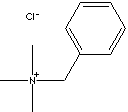| CAS
NO. |
56-93-9 |

|
| EINECS
NO. |
200-300-3 |
| FORMULA |
C6H5CH2N(CH3)3Cl |
| MOL
WT. |
185.70 |
|
H.S.
CODE
|
2923.90 |
|
TOXICITY
|
|
| SYNONYMS |
Trimethylbenzylammonium
chloride; |
| Ammonium,
benzyltrimethyl-, chloride; N,N,N-Trimethylbenzenemethanaminium
chloride; BTM; TMBAC; cloruro de benciltributilamonio
(Spanish); Chlorure de benzyltributylammonium (French);
|
| PRICE |
|
|
CLASSIFICATION
|
|
|
GENERAL
DESCRIPTION OF PHASE TRANSFER CATALYSIS
|
|
'Phase
transfer catalysis (PTC)' methodology
is a powerful tool improving process
efficiency, product selectivity and
providing mild reaction conditions in
organic chemical reactions. In many
chemical reaction situations, there
are different species (immiscible liquids
or solid and liquid) which don't react
each othrer due to separattion by an
interface. Small quantity of ��phase-transfer
catalyst��, involves a substrate (soluble
in the organic layer) and an anionic
reagent or a nucleophile (dissolved
in the aqueous layer), extracts one
of the reactants, most commonly an anion,
across the interface into the other
phase where reaction can take place
with the substrate and reaction can
proceed. The quaternary ammonium salts
can carry the nucleophile from the aqueous
to organic phase and are used as the
most commonly used as phase-transfer
catalyst��. The phosphonium derivatives
favoring higher thermal stability property
are also used. Crown ethers and polyethylenglycol
compounds are also widelt used in this
application.
|
|
PHYSICAL
AND CHEMICAL PROPERTIES
|
| PHYSICAL
STATE |
White
to off-white crystalline powder |
|
MELTING
POINT
|
236
C (Decomposes) |
| BOILING
POINT |
|
| SPECIFIC
GRAVITY |
1.05 |
|
SOLUBILITY
IN WATER
|
soluble |
|
pH
|
|
|
AUTOIGNITION
|
|
| VAPOR
DENSITY |
6.4 |
|
NFPA
RATINGS
|
|
|
REFRACTIVE
INDEX
|
|
| FLASH
POINT |
Not
expected to be a fire hazard |
| STABILITY |
Stable
under ordinary conditions (Hygroscopic)
|
|
GENERAL
DESCRIPTION & APPLICATIONS
|
Quaternary ammonium compounds are any of a group of ammonium salts in which
organic radicals have been substituted for all four hydrogens of the original
ammonium cation. They has a central nitrogen atom which is joined to four
organic radicals and one acid radical. The organic radicals may be alkyl, aryl,
or aralkyl, and the nitrogen can be part of a ring system. They are prepared by
treatment of an amine with an alkylating agent. They show a variety of physical,
chemical, and biological properties and most compounds are soluble in water and
strong electrolytes. Such compounds include
- Benzalkonium
Chloride ( CAS RN: 8001-54-5)
- Benzethonium Chloride CAS
121-54-0
- Cetalkonium Chloride( CAS
122-18-9)
- Cetrimide ( CAS 8044-71-1)
- Cetrimonium Bromide
( CAS 57-09-0)
- Cetylpyridinium Chloride
(CAS 123-03-5)
- Stearalkonium Chloride
( CAS 122-19-0)
They have properties of
disrupting micro-organisms' cell processes and surfactants. These compounds are
used as
- Active Ingredient for
Conditioners
- Antistatic Agent
- Detergent Sanitisers
- Softner
for textiles and paper products
- Phase
Transfer Catalyst
- Antimicrobials
- Disinfection Agents And
Sanitizers
- Slimicidal Agents
- Algaecide
- Emulsifying Agents
- Pigment Dispersers
|
| SALES
SPECIFICATION |
|
POWDER
|
|
APPEARANCE
|
White
to off white crystalline powder |
| ASSAY |
99.0%
|
|
FREE
AMINE
|
0.5%
max
|
|
ASH
|
0.5%
max
|
|
MOISTURE
|
0.5%
max
|
|
60%
SOLUTION
|
|
APPEARANCE
|
Clear
to pale yellow liquid |
| ASSAY |
60.0%
min
|
|
pH
|
6
- 9 (10% Sol.) |
| COLOUR
(HAZEN) |
100
max
|
| TRANSPORTATION |
| PACKING |
|
| HAZARD
CLASS |
Not
regulated |
| UN
NO. |
|
| OTHER
INFORMATION |
| Hazard Symbols: XI, Risk Phrases: 36/37/38,
Safety Phrases: 24/25 |
| GENERAL DESCRIPTION OF DISINFECTANT |
Disinfectant is
an agent applied to inanimate objects to destroy, neutralize, or inhibit the
growth of disease-carrying microorganisms, (whereas antiseptics are applied
primarily to living things). Heat and radiation are also disinfectants. Common
ingredients of chemical disinfectant are:
- Mercuric
Chlorides
- Formaldehyde
- 8-Hydroxyquinoline
- Copper
Hydroxide
- Cresols
- Alcohols
(Ethyl Alcohol; Isopropyl Alcohol)
- Iodines /
Iodophors
- Chlorine
releasing compounds
- Gluteraldehyde
- Phenolics
- Quaternary
Ammonium Compounds
|
| PRICE |

|
